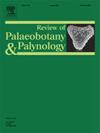Qualitative LM and SEM study of the Messel palynoflora: Part II. Fabales to Caryophyllales
IF 1.7
3区 地球科学
Q2 PALEONTOLOGY
引用次数: 0
Abstract
This second part of the re-investigation of the Eocene Messel palynoflora, using combined light- and scanning electron microscopy (single-grain method), comprises pollen of the Fabales to Caryophyllales. During our study, we discovered one Fabales pollen type, eight Rosales, 20 Fagales, ten Malpighiales, two Myrtales, twelve Sapindales, eleven Malvales, three Santalales, and a single Caryophyllales pollen type. New taxa in the Messel palynoflora includes Erythrina (Fabaceae) and Moraceae. Continuing to compare the palynoflora and meso/macroflora, we notice that additional six families only occur in the microflora, and six other families are represented only by leaf/fruit/seed fossils. Pursuing our assessment of the pros and cons of the combined versus classical quantitative light microscopy studies, we show that the combined method continues to provide a higher diversity of pollen taxa from the plant groups encountered. We report a similar pollen diversity for the orders Fabales to Charyophyllales from a single sample, as previously reported from conventional LM analyses of multi-sampled drill cores. Our combined LM/SEM approach revealed several new floral elements and enabled us to revise several previous botanical affinities based on additional morphological characters observed with SEM.
禾草的定性LM和SEM研究(二)。寓言属到石蕊属
第二部分是对始新世麦塞尔孢粉植物的再调查,采用光和扫描电子显微镜(单粒法)联合研究,包括fabale到caryophyllale的花粉。在研究过程中,我们发现了1个Fabales花粉类型、8个Rosales花粉类型、20个Fagales花粉类型、10个Malpighiales花粉类型、2个Myrtales花粉类型、12个Sapindales花粉类型、11个malvalales花粉类型、3个Santalales花粉类型和1个Caryophyllales花粉类型。禾草植物的新分类群包括赤藓属(豆科)和桑科。继续比较孢粉区系和中/大区系,我们注意到另外6个科只存在于微生物区系中,另外6个科只存在于叶/果/种子化石中。我们对联合定量光学显微镜研究与经典定量光学显微镜研究的利弊进行了评估,结果表明,联合方法继续从所遇到的植物群中提供更高多样性的花粉分类群。我们报告了一个单一样本中Fabales目与Charyophyllales目的花粉多样性,正如之前报道的对多个采样岩心的常规LM分析一样。我们的LM/SEM结合方法揭示了一些新的花元素,并使我们能够根据SEM观察到的其他形态特征修改先前的一些植物亲和性。
本文章由计算机程序翻译,如有差异,请以英文原文为准。
求助全文
约1分钟内获得全文
求助全文
来源期刊
CiteScore
3.50
自引率
21.10%
发文量
149
审稿时长
6 months
期刊介绍:
The Review of Palaeobotany and Palynology is an international journal for articles in all fields of palaeobotany and palynology dealing with all groups, ranging from marine palynomorphs to higher land plants. Original contributions and comprehensive review papers should appeal to an international audience. Typical topics include but are not restricted to systematics, evolution, palaeobiology, palaeoecology, biostratigraphy, biochronology, palaeoclimatology, paleogeography, taphonomy, palaeoenvironmental reconstructions, vegetation history, and practical applications of palaeobotany and palynology, e.g. in coal and petroleum geology and archaeology. The journal especially encourages the publication of articles in which palaeobotany and palynology are applied for solving fundamental geological and biological problems as well as innovative and interdisciplinary approaches.

 求助内容:
求助内容: 应助结果提醒方式:
应助结果提醒方式:


